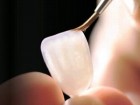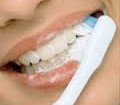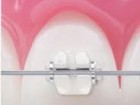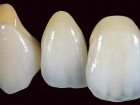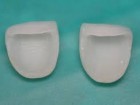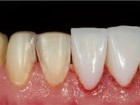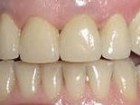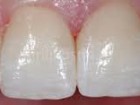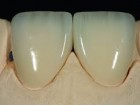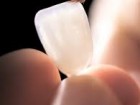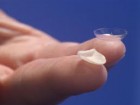Veneers
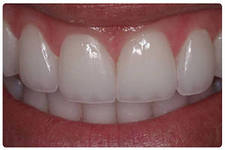
Veneers are microprostheses that allow you to restore the color and shape of one or a group of teeth.
Veneer plates are installed on the front surface of the tooth. They are used to restore the front teeth that fall into the smile line.
Teeth with veneers are no different from real ones, since the tooth color of the patient is taken into account in their manufacture.
Veneer plates are used in cases where restoration and teeth whitening do not give the desired result. Restoring teeth with veneers allows you to quickly restore teeth with large defects.
Types of veneers on teeth
Veneers are made from ceramics and reflective composite materials.
Classification veneers, by the type used for the manufacture of plate material, may be as follows:
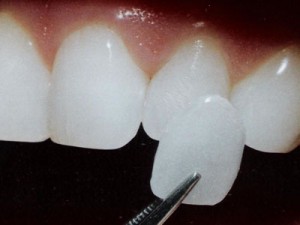
- Ceramic veneers. For their manufacture, medical porcelain and zirconia are used. They are considered the best, because they have high strength, do not change color over time, and externally indistinguishable from real teeth. The thickness of ceramic veneers is only 0.3 - 0.5 mm.
- Composite veneers. This type of veneer is obsolete and less preferred, as it has many drawbacks from an aesthetic point of view and limitations in service life. The advantages of their use are the speed of installation (in the dentist’s office) and the gentle method.
- A variety of porcelain ceramics - Hollywood laminates. The thickness of such plates is only 0.2 mm. Compared to conventional porcelain veneers, they are easier to use and have a longer service life. The technique of their manufacture allows not to grind the tooth enamel. Hollywood veneers can be glued to artificial crowns.
Stages of making veneers
There are two technologies for making ceramic veneers:
- Layering ceramic mass followed by firing (unpressed ceramic).
- Injection molding at high temperature under pressure (pressed ceramic). This technology allows you to create very durable veneers. Their service life is longer than designs made from unpressed ceramics.
Composite veneers can be made in two ways:
- In the dentist’s office. Such designs are called therapeutic veneers or direct veneers. The doctor removes a small layer of enamel on the front surface of the tooth, and then, layer-by-layer, applies light-polymer composite material to it, restoring its surface.
- In the office of a dental technician. To do this, the dentist grinds the tooth under the veneer and takes a cast. In the laboratory, a plaster impression of the teeth is made by cast. It will simulate a veneer made of composite materials.
Making veneers from ceramics
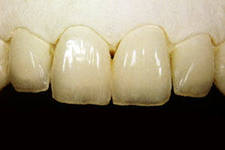
- Preparation for veneers of teeth and the manufacture of three-dimensional cast.
- The computer is modeling the future veneer.
- Turning the structure on a milling machine made of zirconium dioxide (without human intervention).
- A temporary laminate is applied to the turned tooth.
- Processing the inner surface of the veneer (roughening it) for better installation.
- The application of cement on the tooth and the inside of the plate and its fixation on the tooth.
Indications for installation
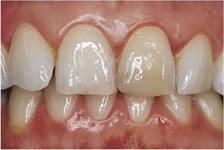
- Pronounced yellowness of the teeth (tetracycline teeth).
- Teeth discoloration due to depulpation.
- Fluorous teeth.
- Enamel erosion.
- Dental defects with extensive damage to hard tissues.
- Incorrect position of the teeth (crowding of the incisors, rotation of the tooth around the axis). Alignment of teeth with veneers looks more aesthetically pleasing if the plates are overlapped not on one tooth, but on several.
- Abnormal tooth shape.
- In the case when restoration activities did not give effect.
- The presence of old fillings, the color of which differs from the color of the teeth.
- Chipped teeth.
- The presence of large interdental spaces.
- Making a Hollywood smile.
Contraindications
- Pathological abrasion of teeth.
- Bruxism (gnashing of teeth).
- Bad habits: biting nails, opening bottles, cracking nuts, etc.
- Veneers are not recommended if the patient has the wrong bite.
- Lack of 6 to 7 chewing teeth.
- Destruction of the tooth from the tongue.
- The presence of a large filling on the inside of the tooth.
- The presence of risk of injury to the front teeth (hobby for boxing, etc.)
How is the installation
Installation of veneer structures takes place in several stages:
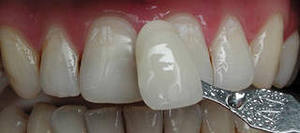
- Preliminary stage. At this stage, it is necessary to determine the material from which the veneer will be made, and also to coordinate the color of the future plate.
- Tooth preparation. Depending on the thickness of the vinyl plate, a layer of hard tooth tissue is removed from the front surface of the tooth.
- Taking a mold from teeth and sending it to the laboratory.
- Installing a temporary plastic plate.
- A gypsum model of the patient’s teeth is made in the laboratory. One of the above methods is used to make a ceramic plate.
- Fixing veneers on a tooth with a special glue.
- Removal of excess cement and bite assessment.
You can install veneers without grinding your teeth. Modern dentistry has in its arsenal this kind of dental structures, which are called "lumineers." Lumineers are thinner than veneers. They are similar to the petals that are glued to the surface of the teeth with dental glue.
Lumineers are standard and individual. Individual designs are made in the laboratory. Standard - are selected, like nails from a set. about glue. more than veneer designs. They are similar to the petals that are glued to the surface of the teeth with dental glue.
Recovery and rehabilitation
- After the veneer is installed, you can lead a normal lifestyle. Follow the doctor's recommendations for the proper use of the design.
- It is possible that in one to two weeks it will be necessary to visit the dentist again for a follow-up examination. The doctor should check the location on the tooth structure and monitor the reaction of the gums to the presence of a vinyl plate.
- As a result of tooth turning, an increased sensitivity of the tooth to cold or hot drinks may occur. The teeth on which the veneers are installed can be destroyed, which can be an indication for covering the tooth with a crown.
Video: “Veneers”
FAQ
Currently, there are various methods of prosthetics with veneers. Which way to give preference? What material to choose for dental prosthetics?
Specialists answer these and other questions of patients.
- Question: Which veneers are better - from porcelain or zirconium?
Answer: Veneers made from porcelain and zirconia look equally aesthetically pleasing.Porcelain veneers are more fragile, so they can break.
- Question: What to choose - a veneer or a crown?
Answer: If there is at least one contraindication to the installation of veneers, then the choice is best made in favor of the crown.
- Question: Can veneers be whitened if they get dark?
Answer: Veneers made of composite materials can get dark. Bleach them will not work. Such designs require replacement.
- Question: Which is better? Restoration or vinyl record?
Answer: Restoration is inferior in many respects to veneers. Therefore, a more reliable way to correct a tooth defect is to install veneers.
- Question: Are veneers harmful to teeth?
Answer: Veneers are absolutely safe for teeth. They are made from biocompatible materials.
Pros and cons of veneers on teeth
Advantages of ceramic veneers to composite:

- High aesthetics of ceramic veneers.
- Veneers made of ceramics remain constant in color, do not fade and do not darken over time.
- Reliability. High wear resistance.
- Biocompatibility.
- Veneers from ceramics - durable. Their shelf life is unlimited.
Disadvantages of ceramic structures:
- Production time is required more.
- Expensive.
- Irreversibility of the preparation process.
- Not repairable.
Advantages of composite veneer restoration:
- They are made quickly, sometimes in one visit to the dentist.
- Cheaper than ceramic veneers.
Composite veneers have disadvantages:

- Short service life.
- Color instability.
- Low esthetic.
- Fragility and unreliability of records.
- Poorly hide tooth defects.
- Irreversibility of the turning process.
- Not repaired.
Veneer Care
- Dental veneers do not require special care.
- Careful daily hygiene of the oral cavity should be followed with a toothbrush, toothpaste and dental floss. This will allow the veneer to maintain a shiny surface.
- Avoid eating foods that tend to stain your teeth (red wine, pomegranate or cherry juice, coffee, tea, etc. foods).
- To minimize the possibility of displacement or loss of veneer, do not put pressure on the teeth in any way (bite ice, nails, nuts, etc.).
- With bruxism during sleep, you must use a mouthguard.
- Once every six months, you need to visit a doctor for a physical examination and possible correction of the veneer.
Prices for veneers
The cost of vinyl records depends on the condition of the patient’s teeth, as well as the construction technology used.
Composite veneers: the cost of one tooth - from 5000 rubles - with a direct method of manufacturing the structure.
The cost of a composite veneer made in a laboratory will be higher, but slightly less than the cost of ceramic veneers.
| Veneers | Price in rubles |
| Restoration veneer | 5000 |
| Porcelain veneer | 14000 |
| Zirconium Veneer | 17000 |
| Hollywood veneers | 15000 |
Life time
Composite veneers have the same strength as fillings. But with good enough oral care, they can have a service life of more than 7 years. Over time, their appearance greatly deteriorates.
Veneers made of ceramics have a longer service life - from 10 years or more.
- They can only fail due to unforeseen situations: getting a hard object on the teeth while eating, injuries, cracking nuts. Opening teeth with bottles, etc.
- After 10 years or more, veneer may fall out due to uncementation. Such a veneer must be brought to the dentist and he will glue it again.
Hollywood porcelain records have served for over 20 years.
Reviews after installing veneers
Of course, we all want to have beautiful teeth. And today there is such an opportunity. Dental veneers are very beautiful and aesthetically pleasing.
But how long will they last? How strong and durable are they? Will these beautiful plates break after the first bite of an apple?
To understand this issue will help reviews of people who have already installed veneers.
- Recently put veneers. I smile with a real Hollywood smile. Beautiful teeth and a smile!
- Put veneers and got a terrible result. Veneers stuck to me immediately without trying on, did not take into account my wishes. In the end: the shape of the veneers is terrible, glued clumsily. I had to redo everything with another doctor.
- Delivered Hollywood veneers. It turned out different colors and different heights. I have been repairing them for two years now.
- They recommended placing veneers on darkened teeth. I didn’t agree right away. Expensive. Then she agreed and it turned out not to hurt at all. The teeth look like real ones.
Photos before and after installing veneers
 |
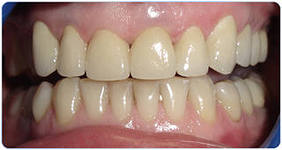 |
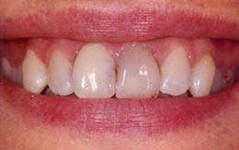 |
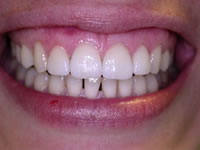 |
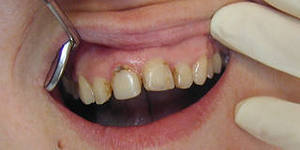 |
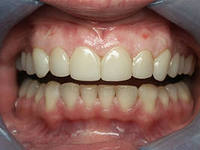 |

